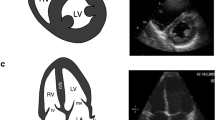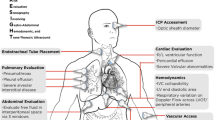Abstract
Purpose of Review
The purpose of this article is to review the literature relevant to point of care ultrasound (POCUS) with an emphasis on the application of ultrasound in preoperative assessment. It addresses the use of cardiac, lung, gastric, and vascular ultrasonography.
Recent Findings
The use of POCUS as an adjunct to the physical examination is gaining traction as high-quality equipment becomes increasingly portable and dramatically more affordable. While the literature on preoperative ultrasound by anesthesiologists is limited, there is growing evidence that it is not only feasible, but also improves patient morbidity and mortality.
Summary
Anesthesiologists frequently encounter patients with signs and symptoms of heart failure, significant cardiac murmurs, hemodynamic instability, unexplained dyspnea, and unknown gastric contents. Studies to date show that POCUS can change management of these patients and improve morbidity without delaying care. Randomized trials are needed to validate these findings. Professional societies in anesthesiology need to define standards for POCUS training, as well as establish mechanisms for certification and maintenance of proficiency.
Similar content being viewed by others
References
Papers of particular interest, published recently, have been highlighted as: • Of importance •• Of major importance
•• Spencer KT, Kimura BJ, Korcarz CE, et al. Focused cardiac ultrasound: recommendations from the American Society of Echocardiography. J Am Soc Echocardiogr. 2013;26:567–58. Society recommendations for standardizing the concept of FOCUS, including a general approach to training and the important distinction between FOCUS and limited TTE.
Di Bello V, La Carrubba S, Conte L, et al. Incremental value of pocket-sized echocardiography in addition to physical examination during inpatient cardiology evaluation: a multicenter Italian study (SIEC). Echocardiography. 2015;32:1463–70.
Kobal SL, Atar S, Siegel RJ. Hand-carried ultrasound improves the bedside cardiovascular examination. Chest. 2004;126(3):693–701. https://doi.org/10.1378/chest.126.3.693.
Committee on Standards and Practice Parameters. Practice advisory for preanesthesia evaluation: an updated report by the American Society of Anesthesiologists Task Force on Preanesthesia Evaluation. Anesthesiology. 2012;116:522–38.
Coker BJ, Zimmerman JM. Why anesthesiologists must incorporate focused cardiac ultrasound into daily practice. Anesth Analg. 2017;124(3):761–5. https://doi.org/10.1213/ANE.0000000000001854.
Anesthesiology TABO Applied Examination-Objective Structured Clinical Examination Content Outline. http://www.theaba.org/PDFs/APPLIED-Exam/APPLIED-OSCE-ContentOutline. 2016;1–5 (Accessed 16 Sept 2017).
• Zimmerman JM, Coker BJ. The nuts and bolts of performing focused cardiovascular ultrasound (FoCUS). Anesth Analg. 2017;124(3):753–60. A detailed description of the techniques of performing FOCUS with numerous images and an accompanying video walking the student through the exam. https://doi.org/10.1213/ANE.0000000000001861.
Via G, Hussain A, Wells M, et al. International evidence-based recommendations for focused cardiac ultrasound. J Am Soc Echocardiogr. 2014;27:683.e1–683.e33.
Galderisi M, Santoro A, Versiero M, et al. Improved cardiovascular diagnostic accuracy by pocket size imaging device in non-cardiologic outpatients: the NaUSiCa (Naples Ultrasound Stethoscope in Cardiology) study. J Cardiovasc Ultrasound. 2010;8:51.
Kimura BJ, Amundson SA, Willis CL, Gilpin EA, DeMaria AN. Usefulness of a hand-held ultrasound device for bedside examination of left ventricular function. Am J Cardiol. 2002;90(9):1038–9. https://doi.org/10.1016/S0002-9149(02)02699-1.
DeCara JM, Kirkpatrick JN, Spencer KT, Ward RP, Kasza K, Furlong K, et al. Use of hand-carried ultrasound devices to augment the accuracy of medical student bedside cardiac diagnoses. J Am Soc Echocardiogr. 2005;18(3):257–63. https://doi.org/10.1016/j.echo.2004.11.015.
Razi R, Estrada JR, Doll J, Spencer KT. Bedside hand-carried ultrasound by internal medicine residents versus traditional clinical assessment for the identification of systolic dysfunction in patients admitted with decompensated heart failure. J Am Soc Echocardiogr. 2011;24(12):1319–24. https://doi.org/10.1016/j.echo.2011.07.013.
Johnson BK, Tierney DM, Rosborough TK, Harris KM, Newell MC. Internal medicine point-of-care ultrasound assessment of left ventricular function correlates with formal echocardiography. J Clin Ultrasound. 2016;44(2):92–9. https://doi.org/10.1002/jcu.22272.
•• Kobal SL, Trento L, Baharami S, et al. Comparison of effectiveness of hand-carried ultrasound to bedside cardiovascular physical examination. Am J Cardiol. 2005;96:1002–6. Compelling study showing that first-year medical students using hand-carried ultrasound had superior diagnostic ability than attending cardiologists not using ultrasound.
• Cowie B, Kluger R. Evaluation of systolic murmurs using transthoracic echocardiography by anaesthetic trainees. Anaesthesia. 2011;66(9):785–90. A limited teaching intervention allowed trainees in anesthesiology to identify significant aortic stenosis. https://doi.org/10.1111/j.1365-2044.2011.06786.x.
Cowie B. Focused cardiovascular ultrasound performed by anesthesiologists in the perioperative period: feasible and alters patient management. J Cardiothorac Vasc Anesth. 2009;23(4):450–6. https://doi.org/10.1053/j.jvca.2009.01.018.
Canty DJ, Royse CF. Audit of anaesthetist-performed echocardiography on perioperative management decisions for non-cardiac surgery. Br J Anaesth. 2009;103(3):352–8. https://doi.org/10.1093/bja/aep165.
Canty DJ, Royse CF, Kilpatrick D, Bowman L, Royse AG. The impact of focused transthoracic echocardiography in the pre-operative clinic. Anaesthesia. 2012;67(6):618–25. https://doi.org/10.1111/j.1365-2044.2012.07074.x.
• Canty DJ, Royse CF, Kilpatrick D, et al. The impact on cardiac diagnosis and mortality of focused transthoracic echocardiography in hip fracture surgery patients with increased risk of cardiac disease: a retrospective cohort study. Anaesthesia. 2012;67:1202–9. Anesthesiologist-performed FoCUS improved mortality of elderly hip fracture patients and did not delay their entry into the operating room.
Botker MT, Vang ML, Grofte T, et al. Routine pre-operative focused ultrasonography by anesthesiologists in patients undergoing urgent surgical procedures. Acta Anaesthesiol Scand. 2014;58(7):807–14. https://doi.org/10.1111/aas.12343.
Zhang J, Critchley LAH. Inferior vena cava ultrasonography before general anesthesia can predict hypotension after induction. Anesthesiology. 2016;124(3):580–9. https://doi.org/10.1097/ALN.0000000000001002.
Feissel M, Michard F, Faller JP, Teboul J-L. The respiratory variation in inferior vena cava diameter as a guide to fluid therapy. Intensive Care Med. 2004;30(9):1834–7. https://doi.org/10.1007/s00134-004-2233-5.
Dipti A, Soucy Z, Surana A, Chandra S. Role of inferior vena cava diameter in assessment of volume status: a meta-analysis. Am J Emerg Med. 2012;30(8):1414–1419.e1. https://doi.org/10.1016/j.ajem.2011.10.017.
Lee C, Kory P, Arntfield R. Development of a fluid resuscitation protocol using inferior vena cava and lung ultrasound. J Crit Care. 2016;31(1):96–100. https://doi.org/10.1016/j.jcrc.2015.09.016.
Khandwalla R, Birkeland K, Zimmer R, et al. Usefulness of serial measurements of inferior vena cava diameter by vscantm to identify patients with heart failure at high risk of hospitalization. Am J Cardiol. 2017;119:1631–6.
•• Lichtenstein D. Novel approaches to ultrasonography of the lung and pleural space: where are we now? Breathe (Sheff). 2017;13(2):100–11. Excellent review and update by the leader in critical care lung ultrasound. https://doi.org/10.1183/20734735.004717.
Soldati G, Testa A, Sher S, et al. Occult traumatic pneumothorax: diagnostic accuracy of lung ultrasonography in the emergency department. Chest. 2008;133:204–11.
Abbasi S, Farsi D, Hafezimoghadam P, et al. Accuracy of emergency physician-performed ultrasound in detecting traumatic pneumothorax after a 2-h training course. Eur J Emerg Med. 2013;20:173–7.
Lichtenstein D, Goldstein I, Mourgeon E, et al. Comparative diagnostic performances of auscultation, chest radiography, and lung ultrasonography in acute respiratory distress syndrome. Anesthesiology. 2004;100:9–15.
• Kruisselbrink R, Chan V, Cibinel GA, et al. I-AIM (Indication, Acquisition, Interpretation, Medical decision-making) framework for point of care lung ultrasound. Anesthesiology. 2017;127:568–82. Review of the approach to lung ultrasound by anesthesiologists.
Practice guidelines for preoperative fasting and the use of pharmacologic agents to reduce the risk of pulmonary aspiration: application to healthy patients undergoing elective procedures: an updated report by the American Society of Anesthesiologists task force on preoperative fasting and the use of pharmacologic agents to reduce the risk of pulmonary aspiration. Anesthesiology. 2017;126(3):376–93. https://doi.org/10.1097/ALN.0000000000001452.
Holt S, McDicken WN, Anderson T, Stewart IC, Heading RC. Dynamic imaging of the stomach by real-time ultrasound—a method for the study of gastric motility. Gut. 1980;21(7):597–601. https://doi.org/10.1136/gut.21.7.597.
Arzola C, Carvalho JCA, Cubillos J, Ye XY, Perlas A. Anesthesiologists’ learning curves for bedside qualitative ultrasound assessment of gastric content: a cohort study. Can J Anesth. 2013;60(8):771–9. https://doi.org/10.1007/s12630-013-9974-y.
Perlas A, Mitsakakis N, Liu L, et al. Validation of a mathematical model for ultrasound assessment of gastric volume by gastroscopic examination. Anesth Analg. 2013;116:357–63.
Alakkad H, Kruisselbrink R, Chin KJ, et al. Point-of-care ultrasound defines gastric content and changes the anesthetic management of elective surgical patients who have not followed fasting instructions: a prospective case series. Can J Anesth. 2015;62:1188–95.
• Perlas A, Van de Putte P, Van Houwe P, Chan VWS. I-AIM framework for point-of-care gastric ultrasound. Br J Anaesth. 2016;116(1):7–11. Review of the approach to bedside assessment of gastric contents with ultrasound. https://doi.org/10.1093/bja/aev113.
Heit JA. The epidemiology of venous thromboembolism in the community. Arterioscler Thromb Vasc Biol. 2008;28(3):370–2. https://doi.org/10.1161/ATVBAHA.108.162545.
Mazzolai L, Aboyans V, Ageno W, et al. Diagnosis and management of acute deep vein thrombosis: a joint consensus document from the European society of cardiology working groups of aorta and peripheral circulation and pulmonary circulation and right ventricular function. Eur Heart J. 2017;00:1–14.
• Pomero F, Dentali F, Borretta V, et al. Accuracy of emergency physician-performed ultrasonography in the diagnosis of deep-vein thrombosis: a systematic review and meta-analysis. Thromb Haemost. 2013;109:137–45. Meta-analysis showing that emergency physicians can diagnose DVT accurately with bedside ultrasound.
Ramsingh D, Rinehart J, Kain Z, et al. Impact assessment of perioperative point-of-care ultrasound training on anesthesiology residents. Anesthesiology. 2015;123:670–82.
Fagley RE, Haney MF, Beraud A-S, Comfere T, Kohl BA, Merkel MJ, et al. Critical care basic ultrasound learning goals for american anesthesiology critical care trainees: recommendations from an expert group. Anesth Analg. 2015;120(5):1041–53. https://doi.org/10.1213/ANE.0000000000000652.
Kimura BJ, Sliman SM, Waalen J, Amundson SA, Shaw DJ. Retention of ultrasound skills and training in “point-of-care” cardiac ultrasound. J Am Soc Echocardiogr. 2016;29(10):992–7. https://doi.org/10.1016/j.echo.2016.05.013.
Author information
Authors and Affiliations
Corresponding author
Ethics declarations
Conflict of Interest
Jen Chang and Josh Zimmerman declare they have no conflict of interest.
Human and Animal Rights and Informed Consent
This article does not contain any studies with human or animal subjects performed by any of the authors.
Additional information
This article is part of the Topical Collection on Preoperative Evaluation
Rights and permissions
About this article
Cite this article
Chang, J., Zimmerman, J. Preoperative Ultrasound: If You Don’t Look, You Don’t Know. Curr Anesthesiol Rep 8, 32–37 (2018). https://doi.org/10.1007/s40140-018-0249-6
Published:
Issue Date:
DOI: https://doi.org/10.1007/s40140-018-0249-6




